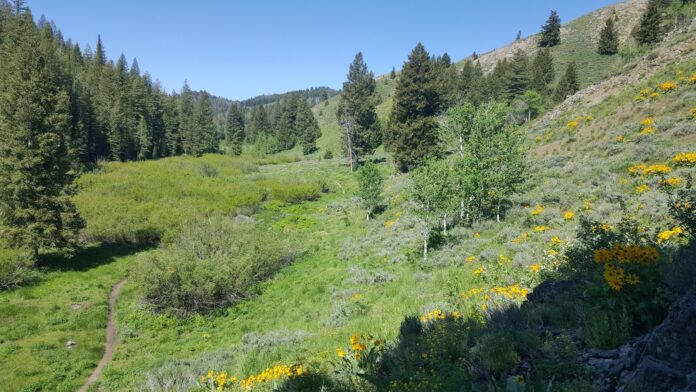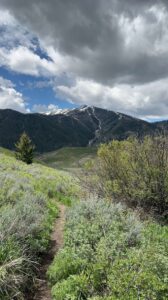
How The Lost Are Found
BY ISAIAH FRIZZELL

It’s always surprising when hikers go missing, especially seasoned outdoors enthusiasts. How does it happen? A number of things can go awry — inclement weather, going off trail, lack of proper preparation, mental or medial impediments, a dreaded injury, dangerous wildlife or simply getting lost. No matter how well you know a trail, a slight detour could mean hours spent finding your way back. Carrying a compass and knowing how to use it, keeping to trail, leaving natural marks, and listening to your body are some basic rules of safe hiking. Even so, the unexpected can happen.
Current Incidents
Just over a week ago, a woman was struck by a falling tree during a hike with her husband and children. She survived, thankfully, but it’s a shocking story — and seemingly rare. Another recent incident is that of Fern Baird, who disappeared from the Prairie Creek trailhead, northwest of Ketchum, on Oct. 19, 2020. She has not been seen or heard from since and as of the week of this writing, Aug. 12-16, 2024, the Fowler-O’Sullivan Foundation is leading the charge, along with public volunteers, in an attempt to find her.
Who’s in charge of Search and Rescue (SAR) and what does it look like to engage in such a venture? How would you go about finding a lost hiker?
Missing Persons Clearinghouse
Idaho law mandates that sheriffs lead the charge in finding “overdue, missing or lost” persons. In addition to all the other duties of the sheriff, they must allocate resources and manpower to search. Some of these missions can go on for months, or even years, such as the Baird case. As of 2023, “the state’s search-and-rescue fund totals around $560,000, most of which is designated for reimbursement for sheriffs’ offices directing searches.” With that size of budget and an already heavy schedule, the need for other entities to become involved is apparent and why groups like the nonprofit Fowler-O’Sullivan Foundation step in. (https://www.eastidahonews.com/2023/10/when-hikers-go-missing-in-idahos-backcountry-who-looks-for-them-and-for-how-long/)
Idaho State Police created what is called the Idaho Missing Persons Clearinghouse (IMPC), established in 1999. This entity serves as a central resource to aid in locating Idaho’s missing persons while supporting law enforcement with statistical data, training, and forms. It works closely with local agencies creating and utilizing large databases to perform the analytical functions related to missing and unidentified persons. The IMPC operates a 24-hour toll-free helpline for information and outreach and while there is no waiting period to report someone missing, obviously the sooner, the better. This suggests one of the golden rules of hiking or backcountry adventuring — tell someone you know what you’re doing, where you’re going and how long you plan to be gone. Typically, you won’t have phone service and unless you have a satellite phone, getting in touch with anyone is difficult, if not impossible. For those wishing to report someone missing, immediate contact with local authorities and the National Center for Missing or Exploited Children is encouraged. More information can be found about IMPC here: (https://isp.idaho.gov/alerts/missing/)
SAR consists of two separate but interwoven resources working together. Search teams focus on locating the missing person via ground search, aerial surveillance and often K-9 deployment. Rescue teams focus on aid, treatment and extraction. A person may not be visibly hurt but the shock of exposure or bewilderment that sets in from being lost and thrust into a life-threatening situation can create emotional and psychological trauma. Extraction teams must be well versed in high-angle and swift-water rescues plus familiarity with rescue equipment. Both teams are cross trained and unified under an Incident Command System (ICS). The ICS is a standardized framework for emergency response. It instantiates a clear chain of command and strongly defined roles for effective communication and coordination. ICS is scalable and adaptable to accommodate emergency response of any size, from a lost hiker to a natural disaster zone.
Mountain Technology
Blaine County stretches over a blend of mountainous terrain, including the valley regions, making it especially challenging to navigate. SAR teams must train constantly for this wide variety of rugged terrain. One of the most important tools used is the Geographic Information System (GIS) and Global Positioning System(GPS). While the U.S. military is currently creating a new GPS system, called M-Code, it is unclear how far along in the testing phase they are. The Air Force launched the first GPS satellite that could broadcast the M-Code signal in 2005 but “delays have plagued the ground and user equipment segments needed to take advantage of the technology.” (https://www.gao.gov/products/gao-22-105086#summary_recommend)
The new system is touted to be better resistant to jamming and interference. The Space Force has also reached a milestone in launching a constellation of 24 GPS satellites broadcasting M-Code. The system is largely related to weapons; however, location data is inherent to operation. Will this help SAR?
SAR teams have an abundance of technology in their quiver. Drones used for aerial surveillance, helicopter search provided by the Idaho National Guard, beacon and RECCO technology to detect reflectors for avalanches, and of course two-way radios for instant communication are all tools to master. SARtopo is their mapping and management software that integrates topographic maps and GPS data for real-time tracking to enhance coordination. These are some of the most challenging environments in the U.S. and it takes a comprehensive set of skills and tools to execute a safe extraction.
Make the Call
In the adverse event that you discover a hiker is missing, you can start by reporting to the Blaine County Sheriff’s Office (BCSO) at (208) 788-5555 or, if critical, 911. Additionally, it would be a good idea to contact the Idaho State Communications Center at (208) 846-7550. They work closely with SAR and law enforcement to handle emergency situations. If children are involved, contact the National Center for Missing and Exploited Children (NCMEC) at 1-800-THE-LOST (1-800-843-5678).
Use any information you have, including finding friends or family via social media who could have been told about the planned excursion but not yet know they’re missing. Should you want to volunteer to help in these situations, contact the BCSO as well as the Idaho State Search and Rescue Association (ISSARA). You can email them at info@issar.org and find more information at www.issar.org.
Again, the most important step for recreating in the out-of-doors is letting people know you’re going on an adventure. Stay safe and enjoy the backcountry responsibly.


